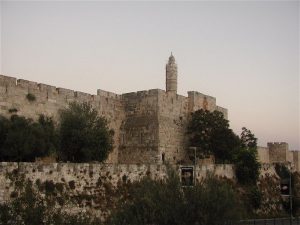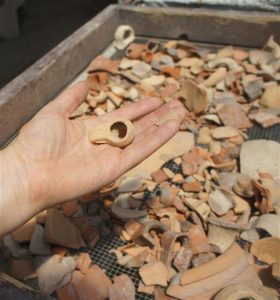In the year 2000, Jerusalem celebrated its 3,000-year anniversary; more specifically, it’s been 3,000 years since Jerusalem was conquered by King David (2 Sam. 5; 1 Chron. 11) and entered the center stage of biblical and world history.
The biblical account clearly states that David did not build Jerusalem. Jerusalem most likely existed
for centuries before David came along. It has been identified with the city of Salem mentioned in Genesis 14, and the king of Jerusalem is mentioned in Joshua 10. The city is also most likely referred to in Egyptian texts dating back as far as 1800 BC. Jerusalem—or Jebus (the city of the Jebusites), as it was called when David conquered it around 1000 BC—was by then already an  established city with a long history. But only in the past few years have excavations in the City of David, in the Jerusalem neighborhood of Silwan, given us a glimpse into the scope and importance of the city prior to David’s arrival on the scene.
established city with a long history. But only in the past few years have excavations in the City of David, in the Jerusalem neighborhood of Silwan, given us a glimpse into the scope and importance of the city prior to David’s arrival on the scene.
In 1995, an excavation led by Prof. Ronny Reich and Eli Shukron was started in preparation for the building of a visitors’ center for the Siloam tunnel, which was discovered in the late 19th century and had been a tourist attraction for many years already. What was supposed to be a routine salvage dig before the start of construction turned into one of the longest ongoing excavations in the history of Jerusalem, and is still ongoing almost 20 years later. What they discovered was sensational and shed some interesting light on the biblical narrative of the conquest of Jerusalem.
Those who criticize the biblical narrative have claimed that the connection between David and Jerusalem is no more than a literary construction intended to create a national identity for the people of Israel. This identity would be centered on an idealized king figure who establishes his kingdom in the city, which becomes the national and religious focal point of the people for three millennia. Why wasn’t this city conquered by Joshua along with the land around it (Judges 1:21)? It sits, quite literally, on the border between the land allocated to the tribes of Benjamin and Judah by Joshua (Josh. 18). Why did the Israelites have to wait for David to come along?
Although the Reich/Shukron excavation has not been able to provide a confirmation of the biblical story of Jerusalem’s conquest by King David, it has provided clear evidence that Jerusalem was a very well-fortified and important city that would have been extremely difficult to penetrate. The excavation unearthed a defensive fortification dating back to 1800 BC that is unparalleled in its size in the Land until the time of Herod the Great. Its purpose was to protect the sole water source of the city, the Gihon spring, and provide the citizens of the city safe access to water even under the most severe siege. Protecting the spring and a large rock-cut water reservoir (15x10m) were two towers: the Pool Tower (14x17m) and the Spring Tower (14x18m). The walls of the Pool Tower were 3.7m thick, while the outer wall of the Spring Tower was as much as 7m thick. This sheds some light on the seemingly exaggerated self-confidence of the Jebusites as they mock David and his army by saying: “You will not get in here; even the blind and the lame can ward you off” (2 Sam. 5:6, NIV). Clearly, they were confident in these fortifications that had withstood any attempt at conquest for eight centuries.
(14x17m) and the Spring Tower (14x18m). The walls of the Pool Tower were 3.7m thick, while the outer wall of the Spring Tower was as much as 7m thick. This sheds some light on the seemingly exaggerated self-confidence of the Jebusites as they mock David and his army by saying: “You will not get in here; even the blind and the lame can ward you off” (2 Sam. 5:6, NIV). Clearly, they were confident in these fortifications that had withstood any attempt at conquest for eight centuries.
Today, for the first time in centuries, these fortifications can be seen; the excavation site was opened to the public in the spring of 2014. Excavations in the City of David continue and attempts are being made to connect the biblical narrative to the archaeological finds. One of the structures found has been cautiously identified by Prof. Eilat Mazar as the palace of King David, although this identification is challenged by other archaeologists. Clearly, there is still much to be discovered.
We may never know exactly how David conquered the city, but what is certain is that with his victory over the Jebusites he conquered what may have been the most well-fortified and important city in the land of Israel. With this, the stage was set for the coming 3,000 years of tumultuous history, which turned Jerusalem into perhaps the most fascinating city in the world.
Sources:
Ronny Reich, Excavating the City of David – Where Jerusalem’s History Began (Jerusalem: Israel Exploration Society and Biblical Archaeology Society, 2011)
Carsten Vang, “Jerusalems historie må skrives om!” in TEL nr. 2, 2014 (Børkop, Denmark: Selskab for Bibelsk Arkæologi, 2014)